Rime Review: No Rhyme or Reason
Tequila Works' third-person adventure game may be pretty, but its emotional core falls flat.
This article first appeared on USgamer, a partner publication of VG247. Some content, such as this article, has been migrated to VG247 for posterity after USgamer's closure - but it has not been edited or further vetted by the VG247 team.
There's a common saying that a picture is worth a thousand words. A picture can transport you to a specific time and place; a memory; a feeling. A picture, as the idiom goes, tells the reader much more than literal words can. As I glance over the 50 or so screenshots I took during my time with Rime, I know at first glance that the island of the game is beautiful. But looking back, it also feels hollow. The opposite of its intent.
Rime might be the most photographable game I’ve ever reviewed. Your hero is always staged in the center (no rule of thirds in place here). Every image is perfectly symmetric—a freshly bloomed tree stands in front of you, or a tower in the distance. And I naturally photographed away, capturing all of the changes along my nearly ten-hour journey. From day to night, grass to desert, sunshine to rain. And when the credits rolled, my digital photos stood as my memories of the experience.
Rime is the latest adventure game from Spain-based developer Tequila Works. We first caught a glimpse of it four years ago, at Gamescom in 2013. The game’s taken many shapes since then. First peddled as an open-world game, then dialing that back to the more linear adventure it is today. Once an Xbox One exclusive, then a PlayStation 4 exclusive, and now neither. The Rime I played was much simpler than its initial concept. Hardly the open world initially dreamed of, but still open with that genre's spirit, ripe for exploration.
Rime opens with a child stranded on an island, washed ashore in the opening moments of the game. As I, playing as the mysterious kid, clamber over a grassy hill, I’m introduced to the vastness of this island I’ve happened upon. The colors that greet me are a mixture of oranges, greens, beiges, and at the foot of it, far away, a tall white tower. Instantly, I knew I had to go there. But not before solving some puzzles and befriending a fox along the way.


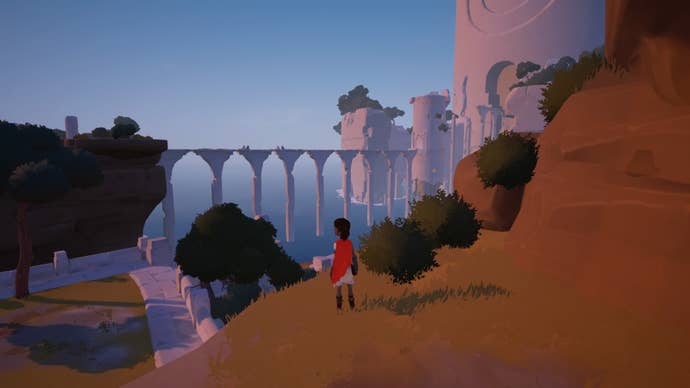
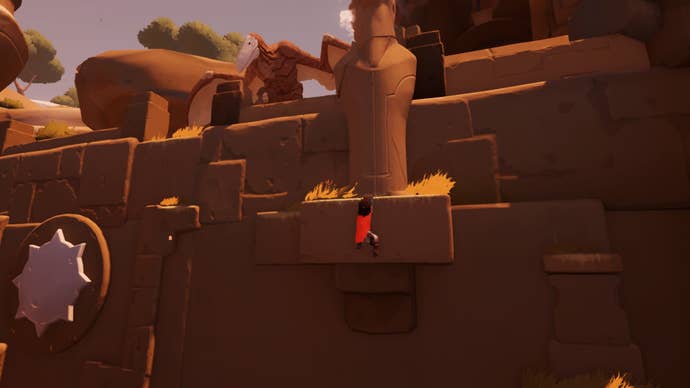
That’s essentially the core loop in Rime: you know in your gut where you must go, and you do miscellaneous tasks—such as baiting a boar with a bright orange fruit to crash through a thorny patch in your way—to get there. If you get lost or side-tracked, your fox will yip in the distance, directing you where to go (at last, we know what the creature says). In most instances, there is something that you call out to with the push of a button, like a statue or an orb, and it will glow at the hum of your voice. Off the beaten path there are always things to uncover: relics, keyholes, toys, other miscellaneous secrets. The extra collectables are there for the dedicated player, if they know where to look.
The world in Rime is a mish-mash of identifiable styles. The architecture looks snatched directly from a surreal Giorgio de Chirico painting. The color palette from the works of Spanish painter Joaquín Sorolla. No spaces are cluttered, nor left completely unembellished. With the two listed as direct influences in past interviews, the similarities crystallize into focus. Yet as I played Rime, I felt a sense of startling familiarity, like I had directly seen this exact flora, these same sculptures and landscapes before in another land (or rather, other games). Like deja vu.
The puzzles in Rime are simple, never challenging in the slightest. Sometimes you’re directing a mechanical thing approximately five times your size to stand on a tile, illuminating it in some way. Sometimes you’re moving an orb around, which changes the time of day accordingly. There are various areas across the island in Rime, all with the looming white tower central. Every area has its central puzzle logic, before the game quickly moves on, abandoning its minor ideas or shifting them in some other way. Yet the minimalistic puzzles are secondary to the adventure the game weaves. Though, even as I trotted through the beautifully styled game that bore familiar art direction, I realized I struggled to engage with it on the emotional level the game was propping the player up to.
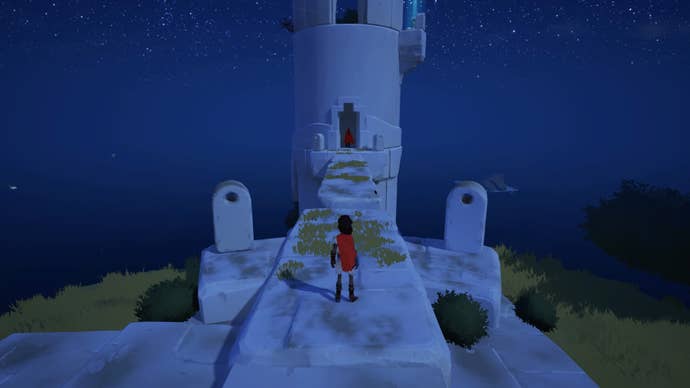

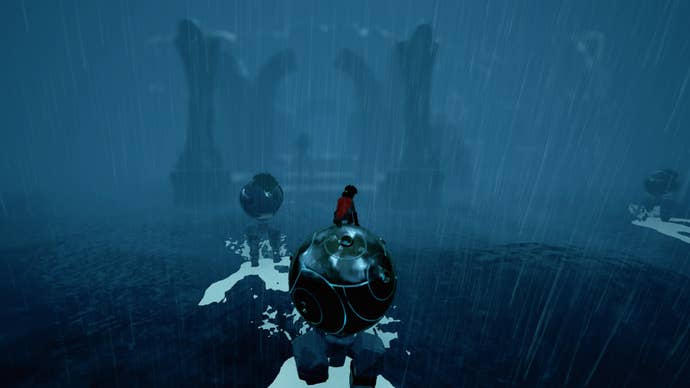
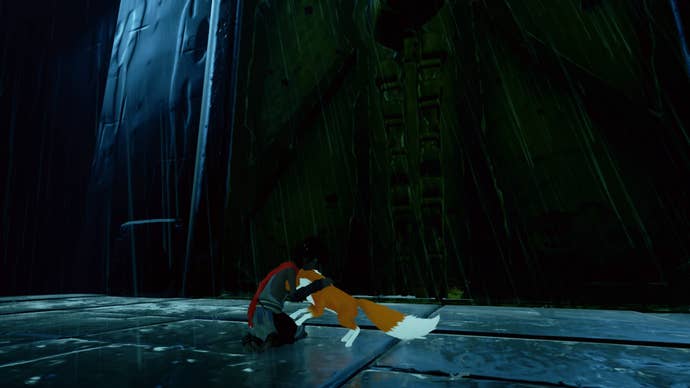

There's more going on in Rime than it initially seems. There’s a mysterious figure always one step ahead of you wearing a long, scarlet cloak, reminiscient of the anonymous being from Journey as they stand in the distance. In-between areas, you get a glimpse of your character off the island and out at sea. Slowly, but surely, you revisit the memory as the game progresses. Yet the mystery falls to the wayside about partway through, as other beings (an evil giant vulture, sorta-robot pals) come into the focus for a brief level or so. As a result, they distract from the game's central heart (or in the robots' cases, resonate more with the player).
I should note that Rime is a wordless game. There is no dialogue, nor even a gibberish-y made-up language of any sort. The only sounds are the striking orchestral score and the desperate, initiated cries of the small child. Rime operates solely on its visuals. In terms of the island you explore and the simple puzzles you solve, it communicates its purpose wonderfully. On an emotional level, by the end section where relationships become clear, I wondered if I was a stoic robot (not even the variety of my friends in the game). The emotional catharsis the game hit felt unearned from what I had seen before. Like a game that had a heart all along, if the heart was buried within the core of the Earth and couldn’t claw its way out until the game’s final hour.
There are games where I look back on the wordless screenshots I took while playing them, and remember fondly why I stopped to soak in the scenery. In some cases, it's for tedious review reasons of recollecting as much of an experience as I can. Yet mostly, they’re for the very same reasons I take a photo in the real world: to preserve a moment. In Rime, the moments were just relishing in the game’s expansive, serene scenery. No feelings caught, no deeper emotional musings had about the sanctity of life. Just a pretty view. Nothing more, and nothing less.
ConclusionRime is a beautiful, beautiful game that manages to feel remarkably empty, even in the face of its earnest attempts. The aesthetic that breathes life into the island of Rime feels a bit too familiar, but it doesn't dampen its vast, ever-photographable horizons. Nonetheless, Rime is a light third-person adventure game with quiet puzzle solving, in a year where we haven't had much of those, which alone makes it a worthwhile respite.

